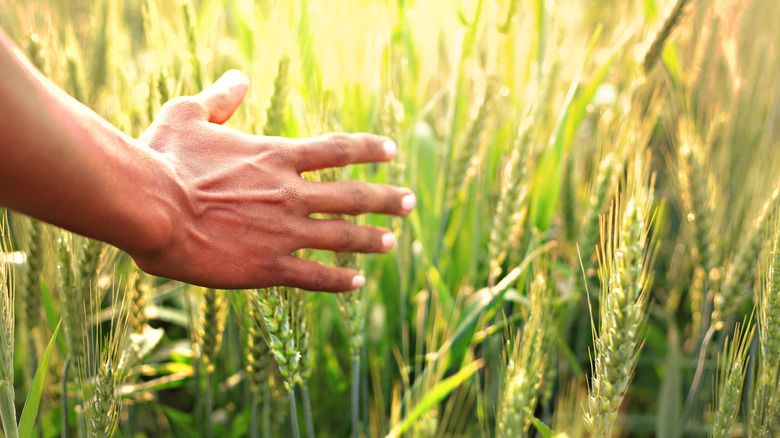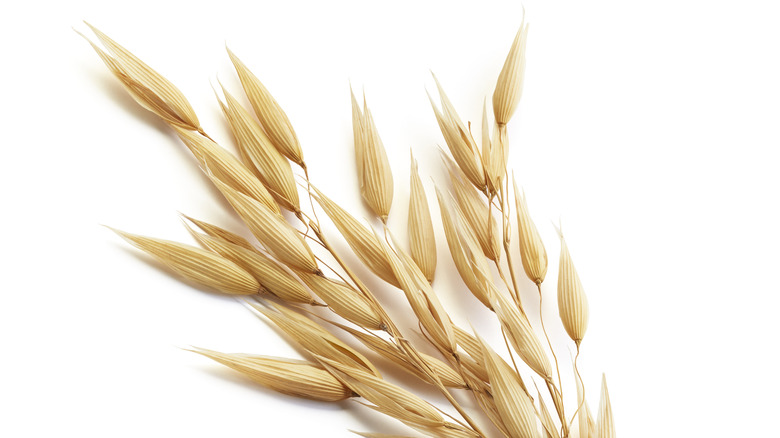The Best Type Of Cover Crops For A Raised Garden Bed (& Which To Avoid)
The gardening practice of growing cover crops in the off-season goes hand-in-hand with the no-till approach offered by raised beds. The benefits of cover crops include weed suppression, microbial health, nitrogen fixing, and soil improvement via added nutrients. Although raised bed gardens are smaller than sprawling agricultural fields, the types of plants and procedural steps involved in managing cover crops are similar in both scenarios. Generally, the gardener plants the cover crop after the fall harvest, allows it to grow until it begins to flower or until frost kills it, and completes the cycle by terminating the crop and incorporating the organic matter into the raised bed soil.
The best cover crops for raised beds offer ease of sowing, fast germination and growth, and ease of handling when it's time to cut down the crop and turn it over. Depending on the soil needs for your raised beds, you'll want to select a cover crop that stands out for a particular function, such as increasing the available nitrogen in the soil, breaking up compaction, or preventing erosion. Read on to learn more about seven cover crops recommended for raised bed gardens. Additionally, you'll want to discover which plants to avoid due to their allelopathic activity.
Winter wheat protects the soil in raised beds during the cold months
Winter wheat is a member of the grass family, and it works like a charm to protect your raised-bed soil throughout the cold season. No, you're not growing wheat to make flour for homemade bread. Instead, you might plant winter wheat due to the capacity for its roots to break up compacted soil. Additionally, it prevents soil erosion in the beds as the leaves slow down the descent of rainwater to prevent run-off.
In the fall, after you harvest the summer vegetables, fruits, and herbs, it's time to sow the seeds of winter wheat. As it grows, the cover crop stores nutrients in its roots, stems, and leaves. Then, in spring, you'll terminate the crop and turn it over, at least two weeks before the next planting, working it into the soil of the raised beds. In large fields, this early spring process starts with mowing. But in small raised beds, you can cut the winter wheat close to the ground with handheld pruning shears (a must-have tool for gardeners) or a string-trimmer. Follow up by incorporating the plant material into the soil with a pitchfork or spade.
Austrian winter peas utilize nitrogen-fixing bacteria to fertilize soil
Think of Austrian winter peas as a natural mulch and fertilizer for the soil in your raised beds. This member of the legume family is a cool-season crop that can boost your soil quality in preparation for spring and summer planting. Austrian winter peas serve as symbiotic hosts for the nitrogen-fixing rhizobia bacteria that live in their roots. These bacteria transform nitrogen from the atmosphere into a usable nutrient that plants can draw from the soil. In addition to amplifying the available nitrogen in your raised bed soil, Austrian winter peas break up compacted soil via their root systems and discourage weeds with their ground-covering capacity.
As a general rule, you should plant a cover crop one month before the first frost date for your area. But Austrian winter peas are exceptionally cold-tolerant and will continue to grow in temperatures that drop below freezing for short periods of time. In fact, the edible shoots of this legume make a tasty contribution to winter salads, and the tender pea pods form around May. A few weeks before planting your summer garden, you should cut down the pea plants and incorporate them into the soil so that the plant material breaks down, serving as an organic fertilizer.
Winter rye offers a slow release of nutrients into your raised bed garden soil
As a cold-weather member of the grass family, winter rye offers benefits for raised-bed garden soil. It sends a substantial root system into the ground, capturing nutrients that otherwise might leach away in winter rain and wind. Then, in early spring, the decomposing organic material from the terminated crop feeds your soil with crucial nutrients for summer crops. The fibrous roots of winter rye break up compacted soil, keeping it aerated and healthy.
Due to its cold tolerance, you can plant winter rye later in the season than more frost-susceptible cover crops. Broadcast the seeds for this grass crop 30 to 45 days before the first killing frost in your area. Cut winter rye down, and incorporate the plant material into your soil a few weeks before spring planting. Be aware that because winter rye puts down deep roots, it requires a bit of muscle and physical exertion to turn it over and work it into your soil.
There is some anecdotal evidence that winter rye acts as an allelopathic plant, releasing a chemical into the soil that negatively affects the growth of other plants. But, according to the U.S. Department of Agriculture, the problem primarily occurs when corn is sown atop the residue of winter rye in farm fields. If you have doubts about growing winter rye as a cover crop in your raised-bed garden, it's a good idea to terminate the crop one month before spring planting, allowing time for the allelopathic chemical to dissipate.
Clover can be grown in raised beds alongside autumn vegetables
Perhaps you grow cool weather vegetables throughout the fall season and until winter brings on the killing frosts. If your fall garden flourishes with broccoli, carrots, spinach, and other veggies that like the crisp autumn air, you can add clover as a cover crop without fear of choking out those plants that you intend to harvest for food. A member of the legume family, clover is a known nitrogen fixer. It enriches your raised bed soil with that crucial nutrient for the crops you'll plant in the spring and summer. As an added bonus, clover acts as a ground cover that deters weed growth in the garden.
Red clover is a common cover crop, as it sprouts easily, and you can sow it in late fall or winter. It is known to grow quickly, even when the seed is broadcast on frozen ground. Crimson clover should be planted in late summer or early fall, allowing 6 to 8 weeks for germination and growth before the first frost of autumn. When the clover reaches the flowering stage, it's time to terminate the crop and work it into your soil. Don't let it go to seed. Allow a few weeks for the material to decompose before planting your spring garden.
Oats are easily incorporated into your raised beds
The real work of managing a cover crop comes in the spring when you cut down the cover plants and incorporate their roots, stems, leaves, and flowers into your garden soil. Oats are relatively easy to cut down and turn over, and their lush foliage contributes plentiful organic matter for building the soil in your raised beds. This member of the grass family blocks weed growth, aerates and improves soil structure, and prevents soil erosion from rainfall run-off.
For a fall crop, plant winter oats 8 to 12 weeks before the first frost of winter. If you prefer raising a cover crop in the early spring, you can sow the oats 4 weeks before the last frost. When the tiny flowers appear, cut down the winter oats, and work the plant matter into the soil with a garden tool. As an alternative, you can leave the terminated crop on the ground as a nutrient-rich mulch that will protect and feed your spring crops.
The taproots of radishes help to aerate during fall growth
While many of the plants used for cover crops are not bound for the dinner table, the root vegetable and the greens from radishes are edible and might end up in many of your winter salads. As a member of the brassica family, the beneficial radish plant sends a taproot of 8 inches or more down into the soil. These roots break up the compacted soil to improve aeration. In the spring, the taproots disintegrate, leaving open space below the surface. When radishes are planted as a spring or summer cover crop, they perform the job of insect control. This phenomenon occurs because the plants contain glucosinolate, a chemical compound that repels harmful insects.
Daikon radishes are a popular cover plant that can be grown in the spring or fall. In climates where the ground does not sustain hard freezes, Daikons will grow throughout the winter. To reap the benefits of a cover crop, do not allow radishes to go to seed. Instead, cut down the crop and incorporate the organic matter into the raised bed soil where it can decompose for a few weeks before you plant the spring or summer garden. As an alternative, you can rake and remove all of the plant material and deposit it in your compost pile.
Buckwheat, used as a cover crop, acts as living mulch for raised beds
Buckwheat is a plant whose name is misleading. It is not a type of wheat and not a member of the grass family. Instead, buckwheat is the edible seed of a plant in the Polygonaceae family. While the seeds of buckwheat can be eaten as a cereal and milled into flour, gardeners who plant it as a cover crop do not intend to use buckwheat as a food source. As a cover crop, buckwheat scores major points for its ability to establish quickly and easily, putting out a dense canopy that shades the soil and suppresses weeds.
A cover crop of fast-growing buckwheat matures in 70 to 90 days. Then it's ready for termination and incorporation into the soil of raised beds. This plant likes cool, moist growing conditions, but frost kills it off. Plant buckwheat 2 to 3 months before the first frost of winter. Then, when it dies, you can leave the plant material on the ground to serve as mulch throughout the cold season. The decomposing matter will add nutrients to your garden soil.
Avoid planting allelopathic plants as cover crops in raised garden beds
Allelopathy is a phenomenon whereby certain plants release toxic chemicals into the air and the soil to discourage the growth of neighboring plants. As a result, the allelopathic plant reduces the competition for water, sunlight, and soil nutrients. For example, Sunflowers release chemicals to protect themselves from competition. The toxins that stunt the growth of nearby plants may be found in the allelopathic plant's roots, leaves, stems, and flowers, making it pervasive in the area where the plant is growing. In the case of cover crops, gardeners do not want to make the mistake of covering their raised beds with an allelopathic plant during the off-season. The toxic chemical might have a negative effect on the vegetables that will be planted in the spring.
Some plants are more susceptible to harm from allelopathic chemicals than others. If you suspect that a plant may exhibit allelopathic tendencies, it's a good idea to research which other plants might be most affected by its toxins. The list of plants that are known to be allelopathic includes sunflowers, goldenrod, garlic mustard, perennial rye, tall fescue grass, and Kentucky bluegrass. If you grow a cover crop that might release an allelopathic chemical into the soil, you can safely plant garden crops after the cover crop is terminated and the chemical disperses. Wait at least 25 days or more before planting your garden vegetables.








